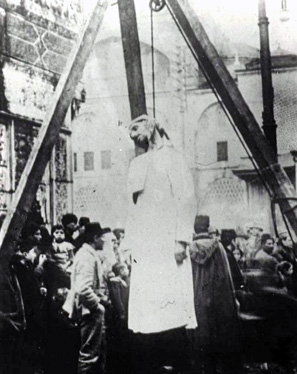 Memorials will be held today in California, Massachusetts, and Michigan marking the anniversary of the Armenian genocides that began in the Turkish Ottoman empire on this day in 1915. During World War I, hundreds of thousands, to millions of the Armenian community were forced on a death-march to Syria and Iraq. The Armenian diaspora in the United States has been urging the US government to formally recognize the deaths of more than a million Armenians as genocide. However, because of close ties between the US and Turkey, officials have been reluctant to comply. Currently, Russia, France, and Canada are among countries describing the events as genocide, while Israel, Britain, and the United States have voiced doubt.
Memorials will be held today in California, Massachusetts, and Michigan marking the anniversary of the Armenian genocides that began in the Turkish Ottoman empire on this day in 1915. During World War I, hundreds of thousands, to millions of the Armenian community were forced on a death-march to Syria and Iraq. The Armenian diaspora in the United States has been urging the US government to formally recognize the deaths of more than a million Armenians as genocide. However, because of close ties between the US and Turkey, officials have been reluctant to comply. Currently, Russia, France, and Canada are among countries describing the events as genocide, while Israel, Britain, and the United States have voiced doubt.
 Members of the Armenian elite were rounded up and executed on April 24th, 1915 at the behest of the Ottoman government. This led to a watershed of persecution against Armenians, as the government forced the deportation of most of their population. A special unit known as the Teskilat-i Mahsusa, or Special Organization, had the mission to exterminate the Armenians. According to Vahakn Dadrian, a preeminent scholar on the Armenian genocide, The Special Organization's mission "was to deploy in remote areas of Turkey's interior and to ambush and destroy convoys of Armenian deportees [The Special Organization's] principal duty was the execution of the Armenian genocide." It is estimated that millions of Armenians died of starvation and disease during their forced deportation.
Members of the Armenian elite were rounded up and executed on April 24th, 1915 at the behest of the Ottoman government. This led to a watershed of persecution against Armenians, as the government forced the deportation of most of their population. A special unit known as the Teskilat-i Mahsusa, or Special Organization, had the mission to exterminate the Armenians. According to Vahakn Dadrian, a preeminent scholar on the Armenian genocide, The Special Organization's mission "was to deploy in remote areas of Turkey's interior and to ambush and destroy convoys of Armenian deportees [The Special Organization's] principal duty was the execution of the Armenian genocide." It is estimated that millions of Armenians died of starvation and disease during their forced deportation.
Other evidence from the Memoirs of Naim Bey, an Armenian compendium of testimonies from survivors of the deportation, gives a more in depth account of the atrocities. According to the accounts outlined in a September 16th, 1915 telegram, the Committee on Union and Progress, the party of the Young Turks, made it policy to "destroy completely all the Armenians living in Turkey." It also makes statements that indicate explicit orders were given by Mehment Talat Pasha, a prominent Young Turk leader, to kill all Turkish Armenians. The media in the US at the time, notably The New York Times, published several accounts of the atrocities and US President Theodore Roosevelt called the massacre "the greatest crime of war."
After the defeat of the Ottoman Empire, the new Turkish government held court-martials proceedings for the Young Turk regime and leaders of the Committee on Union and Progress. The charges included genocide. At least six domestic tribunals were assembled in cities were the atrocities occurred, with the main trial beginning in Istanbul a year after the deportations. Written testimonies from the tribunals described official orders to murder and exterminate the Armenian population. One tribunal resulted in the hanging of a former governor, though others received harsh prison terms.
The tribunals and the use of "genocide', however, have been widely debated. Due process and normal rights to counsel were not honored for the accused. In addition, the rights of cross examination were withheld, as well as the ability to call witnesses. The presiding judge also served a prosecutor, questioning the accused and determining admissible evidence. In addition, all of the official documentation of the proceedings is "missing", relegating details to secondhand accounts.
Turkey has criticized countries that officially acknowledge the deaths of Armenians as deliberate and the penal code there makes it illegal to recognize the Armenian genocide. Though officially not part of negotiations, many European members, including the French President Jacques Chirac, have linked acknowledgement of the Armenian genocide to Turkey's admission to the European Union. Turkey is in the midst of presidential elections and the issue remains contentious today.
This report is derived from “Revisiting the Armenian Genocide” by Guenter Lewy in the Middle East Quarterly.